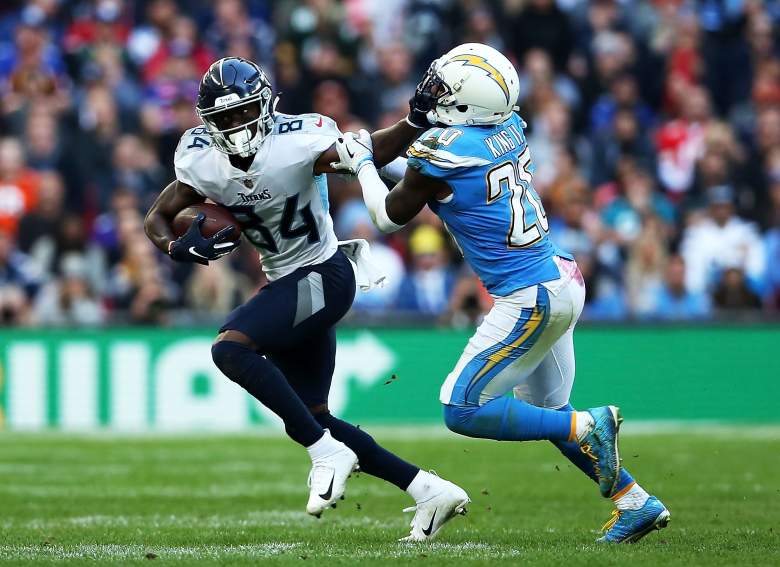
Getty Corey Davis stiff-arms Desmond King in a game on October 21, 2018.
New York Jets fans have been clamoring for a proper number one wide receiver for years now. They have not seen a receiver surpass 1,000 yards receiving since Brandon Marshall and Eric Decker did it the same season in 2015.
Of course, there has been a lot wrong with the Jets offense in recent years, and few players have stuck around long enough to make an impact. Fans will hope that changes soon, and free-agent acquisition Corey Davis would be a nice place to start.
The former first-round pick with the Tennessee Titans hit the open market this offseason, and general manager Joe Douglas scooped him up on a three-year $37.5 million deal. Although he never lived up to his draft status in Tennessee, Davis’ efficiency as a pass-catcher was near the top of the list in 2020.
Based on a combination of catch rate and expected catch rate, Davis had the fifth-best hands in the NFL last season and the fourth-best amongst wide receivers. The wide-out matched his career-high for receptions (65) last season and topped highs in nearly everything else.
Although he fell just short of 1,000 yards receiving at 984, Davis only played 14 games (12 starts) and his average of 70.3 yards per game would have put him well over the four-digit marker if he hadn’t missed time.
Underutilized With Titans
Davis had incredible potential out of college, but the Tennessee offense never seemed to unlock his game. Pro Football Focus scouted him as an “excellent route-runner who can separate really well,” a playmaker who’s “dangerous in the open field,” and a wide receiver that “excels at making adjustments when the football is in the air.”
So why didn’t he blossom into a true NFL WR1?
Part of the problem was his amount of targets in the Titans run-first offense. Last season, the top wide receivers in the game saw 160-plus targets, but the average amount for a typical WR1 was somewhere around 130-140 targets.
Davis only received 92 targets in 2020, but even during his time as a WR1 in Tennessee, his career-high in targets was only 112. He failed to reach 70 targets in both his 2019 and 2017 (rookie) campaigns.
The Titans ranked third in offensive run-play percentage in 2020, fourth in 2019, and second in 2018. The only franchise that consistently ran more over the past two seasons was the Baltimore Ravens, and Tennessee even had them beat three years ago.
Another issue was the quarterback play in Tennessee, a factor Jets fans are all-too-familiar with themselves. Since Davis was drafted in 2017, this was the list of Titans’ starters at the quarterback position before Ryan Tannehill took over mid-way through 2019:
- Marcus Mariota, 34 starts
- Blaine Gabbert, 3 starts
- Matt Cassel, 1 start
Mariota has a career completion percentage of 62.9 and is no longer a starting quarterback. Gabbert has never been more than a backup in his career and has a completion percentage of 56.2. During a full season with Tannehill in 2020, Davis put together his best work since entering the league.
Sure, this latter portion of the argument hinges on Zach Wilson a bit, but the Jets brass believes he will develop into an impressive NFL quarterback.
Davis Fits Into West Coast Scheme
Another positive is that Davis already has familiarity with the west coast system that Mike LaFleur runs. Older brother Matt LaFleur was hired as the Titans offensive coordinator in 2018, which led to Davis’ second-best output during his four-year run.
Arthur Smith then took over when Matt LaFleur moved on to a head coaching role the following season, another disciple of the Mike Shanahan coaching tree. Despite the fact that he utilized a similar run-heavy play-action system, Davis struggled in the first year under Smith. As noted above, the second campaign (2020) with his third offensive coordinator was much better.
The plan is for Mike LaFleur to stick around a while in New York, so Davis and Wilson can grow together in this scheme. The Jets OC spoke on Davis during his media day, noting that he thinks the wide receiver is particularly good in this system because: “He’s got physicality, he’s got size, and he could put his foot in the ground [with a] one-foot cut and separate.”
LaFleur also talked up Davis’ fearlessness in the air, and it doesn’t hurt that he’s a tremendous blocker in the outside-run scheme.
If Davis can stay on the field, he’s the no-doubt number one option for Wilson as a rookie. The Jets must find ways to get him the ball more than the coaches did in Tennessee, and the results should follow.
Do you think Davis can break the Jets’ 1,000-yard receiving drought in 2021? Comment on Facebook @HeavyOnJets or Twitter @obermuller_nyj or @BoyGreen25 and let us know!